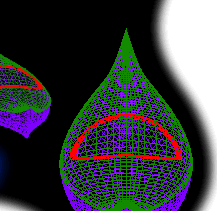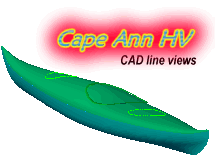


 |
 |
|
| The "Kayaks in Plans" page is the home of experimental models and resized versions of existing One Ocean Kayaks designs. |  |
| Cape Ann HV - Efficient, large volume touring kayak for large paddlers and 'expedition' gear loading. | ||
| Expedition Sport - High performance touring kayak for medium weight paddlers | ||
| Storm LT - (light) High performance cruiser for small to medium sized paddlers | ||
| Storm SLT - (super light) Lightest cruising kayak for smaller paddlers | ||
|
Choosing a kayak - a few considerations and tips about selecting the right type of kayak to fit your size, skill and paddling style. Some points about kayak seaworthiness |
||
|
Kayak comparison page - see how all One Ocean Kayaks designs compare in size, wave resistance and viscous (friction) drag. |

| Kayak
Design specs... The stuff that actually tells you something |
Storm
LT - 16.25'
x 21.5" ( 4,95 x 0,546m) |
| Design Features | |
Kayak
Building Plans 
|
|

| Kayak
Design specs... The stuff that actually tells you something |
Storm
SLT - 15.5'
x 21.5" ( 4,72 x 0,546m) |
| Design Features | |
Kayak
Building Plans 
|
|

| Kayak
Design specs... The stuff that actually tells you something |
Expedition
Sport - 16'
9" x 21.5" ( 5,1 x 0,546m) |
|
I took the Sport out this past week... It slices through the water like crazy! - John Wentz (Fire Captain from Puget Sound, Washington) ... Now that I've had the boat out a few times, I am very impressed with the handling. So easy to roll, too. I appreciated the excellent and the most complete set of plans I've received from any designer. The manual was very helpful too. Thanks, John Caldeira (Texas) ... I have just finished a 90K trip in 3 days that took me around the south east corner of Australia. We had seas from 2-3.5 metres and winds of up to 30 knots (at the same time) and the loaded Expedition Sport went a treat. I kept up with 2 good paddlers in a double (not without effort) and just had a ball. We travered parts of the coast that have small rivers with no human habitation above tham at all. The scenery was sensational, and we traveresed 50 K of coast without seeing any human presence at all...we caught a feed every night, and threw more back. Had I not made the effort to build your fine design, I would probablay never have done it...Cheers, Matt (Australia) Design Features |
|
Kayak
Building Plans 
|
|

| |
| Kayak
Design specs... The stuff that actually tells you something |
Cape
Ann HV - 18'
6" x 24" ( 5,63 x 0,6096m) |
|
Cape Ann HV built by Clas Kreutzman in Finland Another picture of the HV made by Jurgen Koppen in Canada Design Features |
|
Kayak
Building Plans 
|
|
| Home | Kayak Designs | Kayak Shop | Materials | Kayak Gallery | About us |
| Building Manual | Plans | Sandwich Core | Wood Kayak | Order | |
| Epoxy Test | Abrasion Cloth | Rudder | Resources | Choosing Kayak | Guestbook |
If you notice any problems with the site (i.e. error links, missing images) please, let me know. Thanks
Mail:
Vaclav Stejskal
58 Wood Ln.
Acton, MA 01720
USA
Tel: 781-481-9261
© 1999 - 2024 Copyright Vaclav Stejskal
All rights reserved
Last page update: 9 May 2024